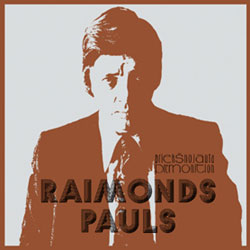
Raimonds Pauls, much like comedian Rodney Dangerfield, at times doesn’t get much respect. He is far and away the best known Latvian popular music composer of the second half of the 20th century, with fans not just in Latvia, but in other such countries as Russia and Japan as well. He has performed all over the world, including New York’s Madison Square Garden. He will mark his 70th birthday in 2006. After all that, why is he still given such a hard time, especially when many, many of his songs are beloved by Latvians? Mega-hits of his include “Dāvāja Māriņai,” “Mežrozīte,” “Kā senā dziesmā” and others too innumerable to mention.
From this usually humble reviewer’s perspective, there is quite a lot of Pauls’ repertoire that I quite like. I guess one might compare him to an artist like Prince (a very talented artist, but who probably releases more material than he should) or perhaps like Bruce Springsteen (his best songs are in a class of their own, but his lesser work all starts to sound the same after a while). Pauls certainly could have been more selective about some of the songs that he released. During the 1970s, when he was releasing albums nearly one a year, some lesser songs that otherwise would have been left unreleased got a space on a record. His jazzy style might unnerve some listeners, while some more snooty listeners comment that there might be some active borrowing from jazz pianists like Dave Brubeck in Pauls’ work.
Due to his prolific release schedule, his albums are a hit-and-miss affair. However, one album that bears further attention is 1977’s Priekšnojauta (Premonition). Re-released on compact disc in 2004 by MICREC as part of its “Latviešu populārās mūzikas klasika” series, this is one of Pauls’ records that stands the test of time and reconfirms Pauls’ place as one of the great Latvian popular music composers.
From the opening swell of strings in the song “Par pēdejo lapu” (About the Last Leaf), the listener can immediately recognize this as a Raimonds Pauls work. Perhaps a bit overly dramatic, this song, with lyrics by frequent Pauls collaborator Jānis Peters, is yet another mega-hit, as popular today as it was when it was first released almost 30 years ago. The song features one of the great Latvian female singers, Nora Bumbiere. Prāta Vētra fans will notice the strong resemblance between their song “Lidmašīnas” and this song—so notable that Prata Vētra credits “Par pēdejo lapu” as the basis for its song on CDs that contain “Lidmašīnas.”
Pauls also has a reputation of working with only the best Latvian singers, and this CD includes a number of them. Besides Bumbiere, there is also Mirdza Zīvere, Viktors Lapčenoks and Vladislavs Juhņevičs.
Another beloved song on this disc is the Lapčenoks-sung “Zied ievas Siguldā” (The Cherry Trees are Blooming in Sigulda), with text by A. Smagars. One might consider Lapčenoks one of the first “rock superstars” in Latvian music, because his style was perhaps more appropriate to rock songs rather than the more mid-tempo estrādes style of most of Pauls’ songs. A personal favorite on this CD is “Nīca” (text by V. Brutāne), a duet between Lapčenoks and Bumbiere, a song where Lapčenoks gets the chance to let loose and sing like a rock star—something rather unusual in 1970s Latvian music!
Lapčenoks and Bumbiere join up again to duet on the final song on the album “Tā diena” (That Day), with text by Jānis Peters, a song with a downright Carribean feel to it. Certainly this song and other songs on this album were experiments for Pauls, and I think they worked out quite well. This is probably one of the reasons I enjoy this album so much, as it is much fresher and sharper than a lot of the stagnant, lounge music style albums that came before it.
Of course, there are some clunkers here that I really could have done without, notably “Rudensogle” (Autumn Ember), performed by Zīvere. The song is far too overwrought for my tastes, especially with the overbearing string section.
One refreshingly consistent aspect of Pauls’ releases (especially those from the 1970s and 1980s) are the dreadful album covers. Priekšnojauta, with its photo of the composer in brown and gray hues, is no exception.
In a rarity for these CDs in the “Mūzikas klasika” series, all lyrics are included, plus a whole two photographs. Though having the lyrics is a bonus, I still think MICREC could be doing more with these releases, even something as simple as getting Pauls and the other artists to write a few sentences about their thoughts on this album, or any memories of recording it, or anything simply to add value to these re-releases.
When faced with the choice of purchasing one of dozens of Raimonds Pauls releases, it can be difficult to determine what the correct choice might be. Priekšnojauta is one of the best of the bunch. Don’t let your snobby friends tell you that all of Raimonds Pauls’ songs sound the same. This album breaks that stereotype, rather convincingly I say. A bestseller in 1977, it still remains one of his most popular albums.
Details
Priekšnojauta
Raimonds Pauls
MICREC, 2004
MRCD 253
© 1995-2024 Latvians Online
Please contact us for editorial queries, or for permission to republish material. Disclaimer: The content of Web sites to which Latvians Online provides links does not necessarily reflect the opinion of Latvians Online, its staff or its sponsors.




